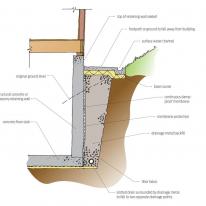Moisture entry through basement walls
Cause
Ground moisture, seen as efflorescence, staining or coating/surface damage on the inside face of a basement wall, moves through the wall from outside
Repair
There are four general repair options.
- install surface water drainage channels around the outer perimeter of the wall, discharging to a stormwater drain or soakpit. This may not be possible and may not stop all the water. (Whichever option is chosen, sloping the ground around the building so rainwater drains away from the building is recommended.)
- the best long-term solution, where it is possible, is to dig out and expose the exterior basement wall and repair or install an effective drainage system (see drawing)
- where this is not possible, another option is to install a trench at the base of the interior wall face, a sump and a pump to remove the water. A new partition wall is constructed inside that. (This reduces heat loss from thermal bridging and also allows wall insulation to be installed at the same time.)
- the easiest and fastest option is to apply proprietary waterproofing products to the inside of the wall, but this is not always successful. Use a reputable applicator and product as usually there is only one opportunity to apply to the virgin surface. Once contaminated by poor application or unsuitable product, it is unlikely any subsequent application will work.
Repair
Excavating to repair/install drainage
- excavate the fill from behind a wall to expose the wall (or waterproof membrane) and any drainage system at the base of the wall. The excavation must extend the below the footing. Ensure that someone knows that you are doing this work
- take great care that the existing earth face behind the excavation is secure. Shoring must be provided for any excavations over 1.5 m in height. Depending on dimensions and scale, engineering advice and design of a temporary retaining structure may be necessary.
- repair or apply a new waterproofing membrane to the outside of the wall. Options include torch-on, brush-on, spray-on, roll-on and adhesive-fixed membranes. Extend the membrane to at least 150 mm above ground surface. In every case follow the manufacturer’s instructions for application
- protect the membrane with fibre-cement, corflute or polystyrene sheet
- the excavated trench (below basement floor level) should have a minimum fall of 1:60 and a base of free draining material at least 100 mm deep
- lay 100 mm perforated drainage coil pipe on this and cover with geotextile filter fabric. The drainage pipe must extend to a discharge point such as a stormwater drain or soakpit via a silt trap. Usually, building consent authorities require a sump in the line (beyond the retaining wall) to prevent backflow behind any retaining walls should a stormwater drain block ahead of the sump. This allows the blockage to overflow at the sump, preventing drains behind the walls becoming primed and pressurising tanking membranes
- backfill with free draining pea metal.
Repair
Internal drain and sump
This option is not common in smaller New Zealand buildings but is widely used in countries where there are many basements fully below ground level.
- install a trench drain and sump to the foot of the internal wall. The drain should have a fall to the sump and a waterproof membrane lining. The sump may be a preformed PVC chamber let into the floor
- install electric sump pumps with float switches to lift water from the sump to a suitable discharge point outside the building. A fail-safe system requires more than one pump and an alarm system to warn of pump failure
- construct a new timber-framed wall with thermal insulation and wall lining
- depending on circumstances a topping slab may also be required. Where this is the case, consider installing underslab insulation.
Repair
Applying waterproofing to the interior wall
Where excavation is not practical, there are proprietary products that can be applied to the interior concrete face of a basement wall. These include:
- expanding silicate sealers and cementitious damp-proofing slurries that react with the concrete, effectively sealing it by filling pores, hairlines cracks and gaps
- water-based epoxy coatings
- specialised expanding resins or grouts that can be injected into larger cracks and construction joints
Follow the manufacturer’s advice for the use of these. In most instances these products work best when the concrete is as dry as possible, so carry out work during a long dry period. Warranties are usually only available when products are installed by licensed applicators. Owners who apply products (even reputable products) themselves will likely be on their own should the product fail.
For more in-depth information, consult the BRANZ Good Repair Guide Leaking basement walls.




